Diversity Challenges and Management: Latitude International Restaurant
VerifiedAdded on 2021/02/19
|30
|5353
|264
Report
AI Summary
This research project delves into the process of managing diversity and the associated challenges encountered by Latitude International Restaurant in London. The report begins with an overview of the research, outlining the background, rationale, aims, objectives, and research questions. A comprehensive literature review explores the concept of diversity in the workplace, highlighting its benefits and the challenges organizations face. The research methodology section details the research philosophy, approach, choice, design, data sources, sampling techniques, and ethical considerations. The findings are presented through thematic analysis, followed by a discussion of the data. The report concludes with a summary of findings, recommendations for effective diversity management, and an acknowledgement of anticipated limitations. The research aims to understand the importance of diversity management and how organizations like Latitude Restaurant can navigate the complexities of a diverse workforce.
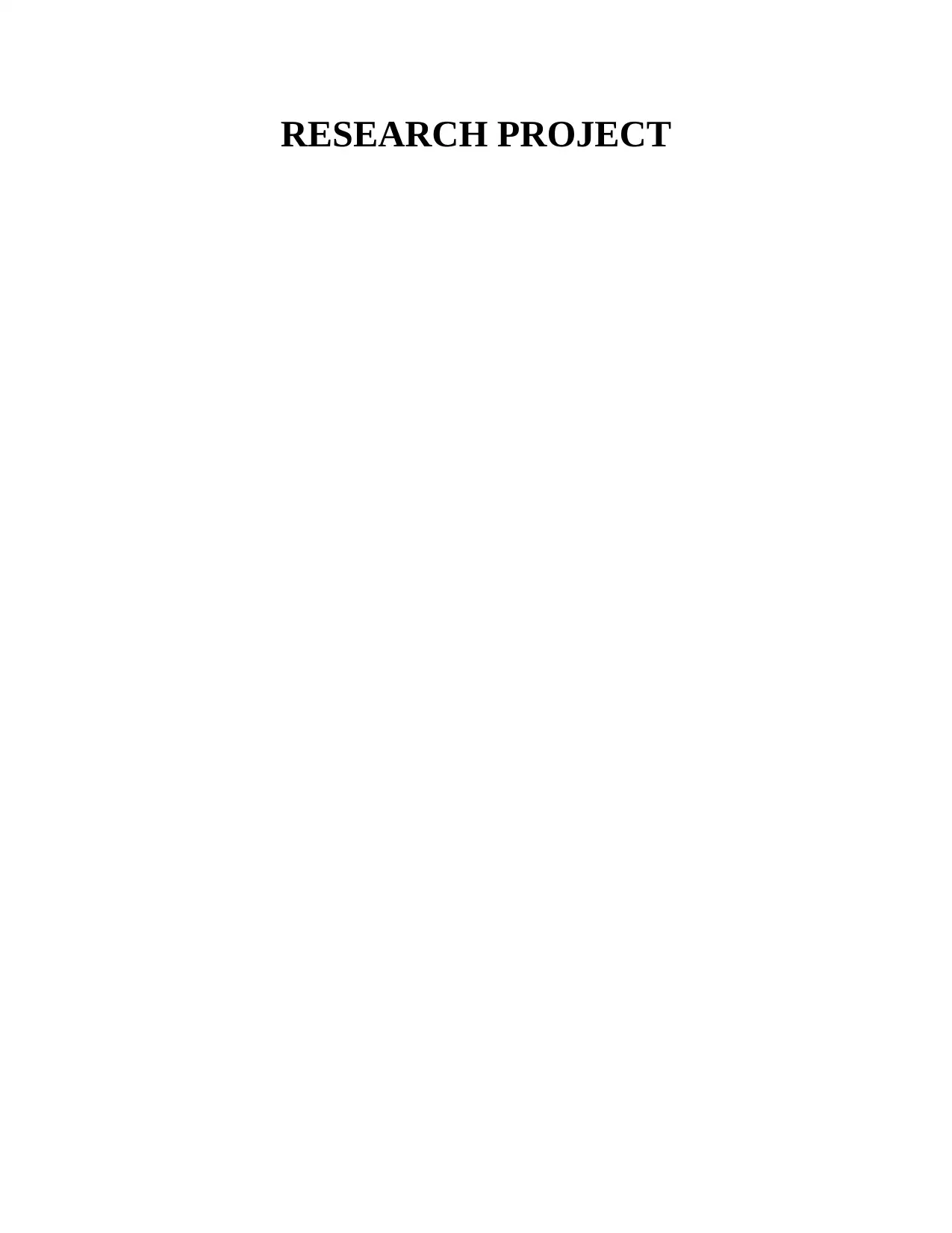
RESEARCH PROJECT
Paraphrase This Document
Need a fresh take? Get an instant paraphrase of this document with our AI Paraphraser
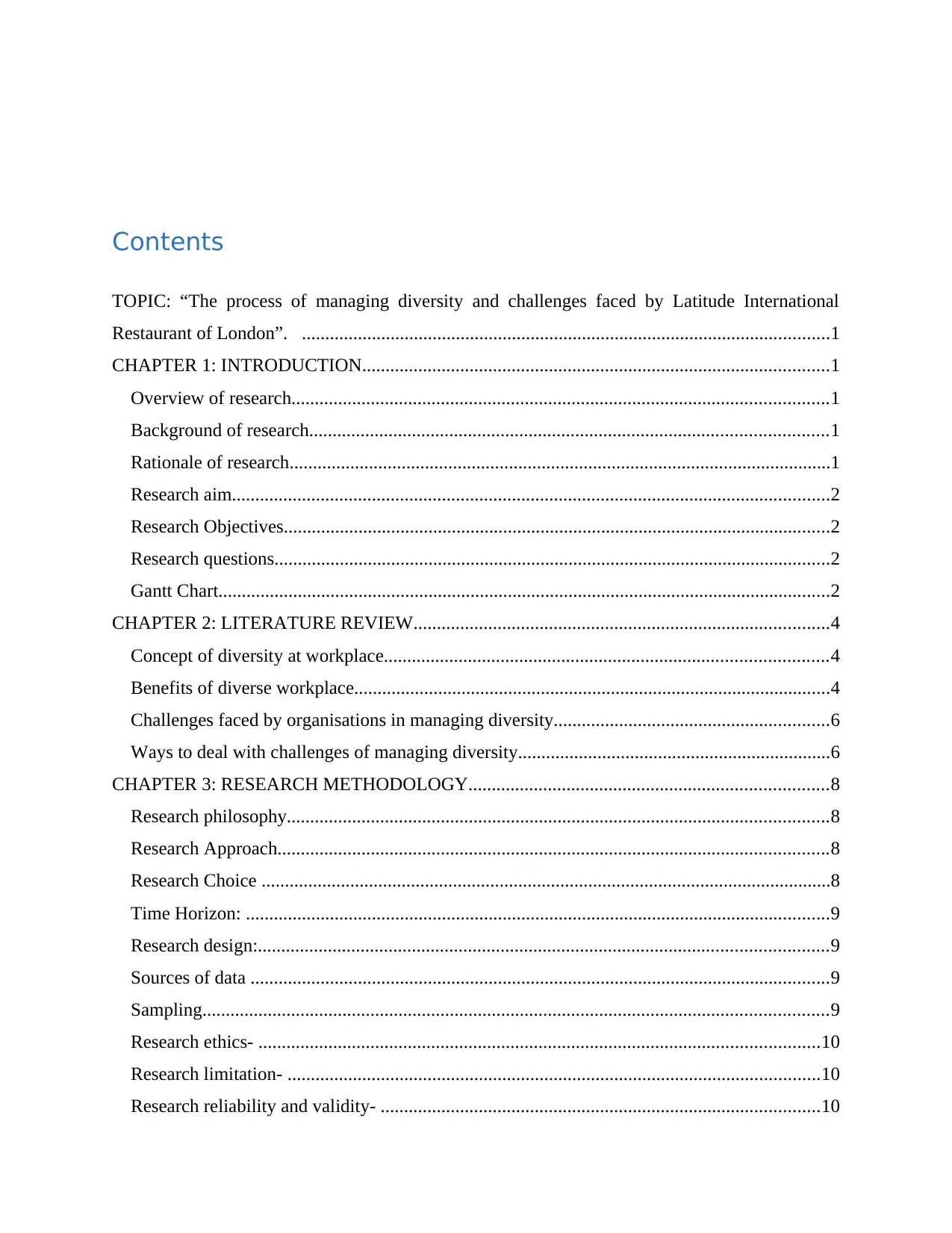
Contents
TOPIC: “The process of managing diversity and challenges faced by Latitude International
Restaurant of London”. .................................................................................................................1
CHAPTER 1: INTRODUCTION....................................................................................................1
Overview of research...................................................................................................................1
Background of research...............................................................................................................1
Rationale of research....................................................................................................................1
Research aim................................................................................................................................2
Research Objectives.....................................................................................................................2
Research questions.......................................................................................................................2
Gantt Chart...................................................................................................................................2
CHAPTER 2: LITERATURE REVIEW.........................................................................................4
Concept of diversity at workplace...............................................................................................4
Benefits of diverse workplace......................................................................................................4
Challenges faced by organisations in managing diversity...........................................................6
Ways to deal with challenges of managing diversity...................................................................6
CHAPTER 3: RESEARCH METHODOLOGY.............................................................................8
Research philosophy....................................................................................................................8
Research Approach......................................................................................................................8
Research Choice ..........................................................................................................................8
Time Horizon: .............................................................................................................................9
Research design:..........................................................................................................................9
Sources of data ............................................................................................................................9
Sampling......................................................................................................................................9
Research ethics- ........................................................................................................................10
Research limitation- ..................................................................................................................10
Research reliability and validity- ..............................................................................................10
TOPIC: “The process of managing diversity and challenges faced by Latitude International
Restaurant of London”. .................................................................................................................1
CHAPTER 1: INTRODUCTION....................................................................................................1
Overview of research...................................................................................................................1
Background of research...............................................................................................................1
Rationale of research....................................................................................................................1
Research aim................................................................................................................................2
Research Objectives.....................................................................................................................2
Research questions.......................................................................................................................2
Gantt Chart...................................................................................................................................2
CHAPTER 2: LITERATURE REVIEW.........................................................................................4
Concept of diversity at workplace...............................................................................................4
Benefits of diverse workplace......................................................................................................4
Challenges faced by organisations in managing diversity...........................................................6
Ways to deal with challenges of managing diversity...................................................................6
CHAPTER 3: RESEARCH METHODOLOGY.............................................................................8
Research philosophy....................................................................................................................8
Research Approach......................................................................................................................8
Research Choice ..........................................................................................................................8
Time Horizon: .............................................................................................................................9
Research design:..........................................................................................................................9
Sources of data ............................................................................................................................9
Sampling......................................................................................................................................9
Research ethics- ........................................................................................................................10
Research limitation- ..................................................................................................................10
Research reliability and validity- ..............................................................................................10
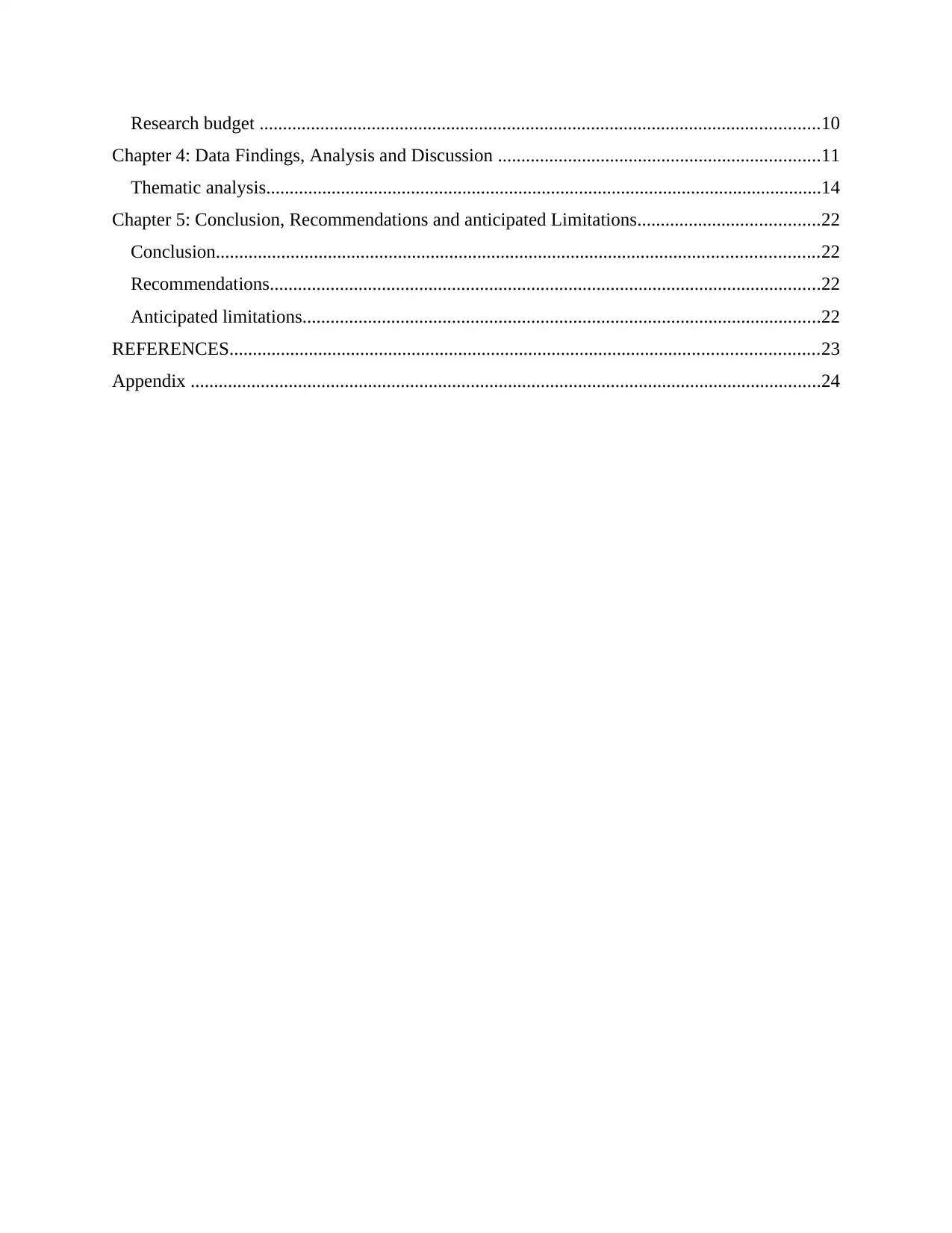
Research budget ........................................................................................................................10
Chapter 4: Data Findings, Analysis and Discussion .....................................................................11
Thematic analysis.......................................................................................................................14
Chapter 5: Conclusion, Recommendations and anticipated Limitations.......................................22
Conclusion.................................................................................................................................22
Recommendations......................................................................................................................22
Anticipated limitations...............................................................................................................22
REFERENCES..............................................................................................................................23
Appendix .......................................................................................................................................24
Chapter 4: Data Findings, Analysis and Discussion .....................................................................11
Thematic analysis.......................................................................................................................14
Chapter 5: Conclusion, Recommendations and anticipated Limitations.......................................22
Conclusion.................................................................................................................................22
Recommendations......................................................................................................................22
Anticipated limitations...............................................................................................................22
REFERENCES..............................................................................................................................23
Appendix .......................................................................................................................................24
⊘ This is a preview!⊘
Do you want full access?
Subscribe today to unlock all pages.

Trusted by 1+ million students worldwide
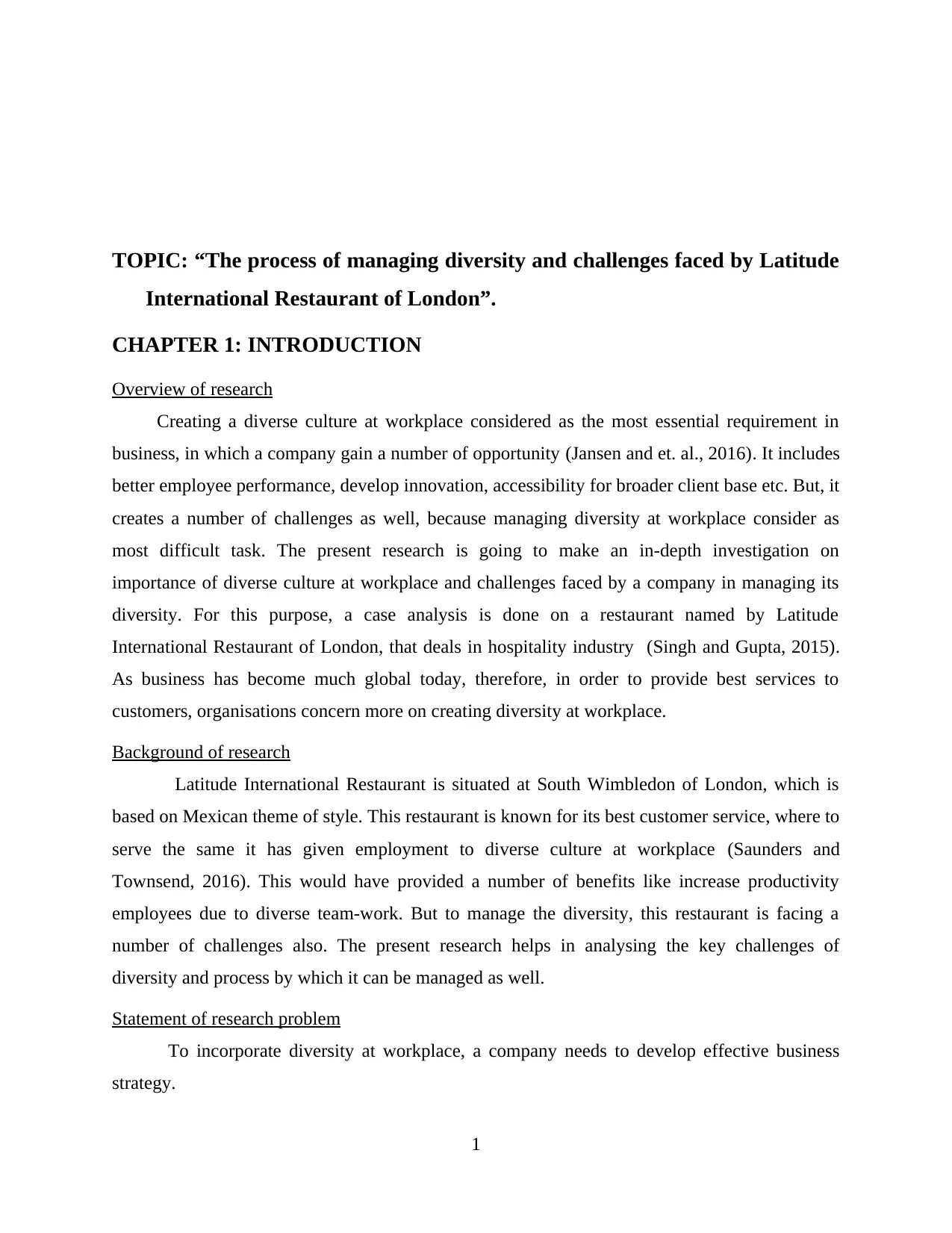
TOPIC: “The process of managing diversity and challenges faced by Latitude
International Restaurant of London”.
CHAPTER 1: INTRODUCTION
Overview of research
Creating a diverse culture at workplace considered as the most essential requirement in
business, in which a company gain a number of opportunity (Jansen and et. al., 2016). It includes
better employee performance, develop innovation, accessibility for broader client base etc. But, it
creates a number of challenges as well, because managing diversity at workplace consider as
most difficult task. The present research is going to make an in-depth investigation on
importance of diverse culture at workplace and challenges faced by a company in managing its
diversity. For this purpose, a case analysis is done on a restaurant named by Latitude
International Restaurant of London, that deals in hospitality industry (Singh and Gupta, 2015).
As business has become much global today, therefore, in order to provide best services to
customers, organisations concern more on creating diversity at workplace.
Background of research
Latitude International Restaurant is situated at South Wimbledon of London, which is
based on Mexican theme of style. This restaurant is known for its best customer service, where to
serve the same it has given employment to diverse culture at workplace (Saunders and
Townsend, 2016). This would have provided a number of benefits like increase productivity
employees due to diverse team-work. But to manage the diversity, this restaurant is facing a
number of challenges also. The present research helps in analysing the key challenges of
diversity and process by which it can be managed as well.
Statement of research problem
To incorporate diversity at workplace, a company needs to develop effective business
strategy.
1
International Restaurant of London”.
CHAPTER 1: INTRODUCTION
Overview of research
Creating a diverse culture at workplace considered as the most essential requirement in
business, in which a company gain a number of opportunity (Jansen and et. al., 2016). It includes
better employee performance, develop innovation, accessibility for broader client base etc. But, it
creates a number of challenges as well, because managing diversity at workplace consider as
most difficult task. The present research is going to make an in-depth investigation on
importance of diverse culture at workplace and challenges faced by a company in managing its
diversity. For this purpose, a case analysis is done on a restaurant named by Latitude
International Restaurant of London, that deals in hospitality industry (Singh and Gupta, 2015).
As business has become much global today, therefore, in order to provide best services to
customers, organisations concern more on creating diversity at workplace.
Background of research
Latitude International Restaurant is situated at South Wimbledon of London, which is
based on Mexican theme of style. This restaurant is known for its best customer service, where to
serve the same it has given employment to diverse culture at workplace (Saunders and
Townsend, 2016). This would have provided a number of benefits like increase productivity
employees due to diverse team-work. But to manage the diversity, this restaurant is facing a
number of challenges also. The present research helps in analysing the key challenges of
diversity and process by which it can be managed as well.
Statement of research problem
To incorporate diversity at workplace, a company needs to develop effective business
strategy.
1
Paraphrase This Document
Need a fresh take? Get an instant paraphrase of this document with our AI Paraphraser
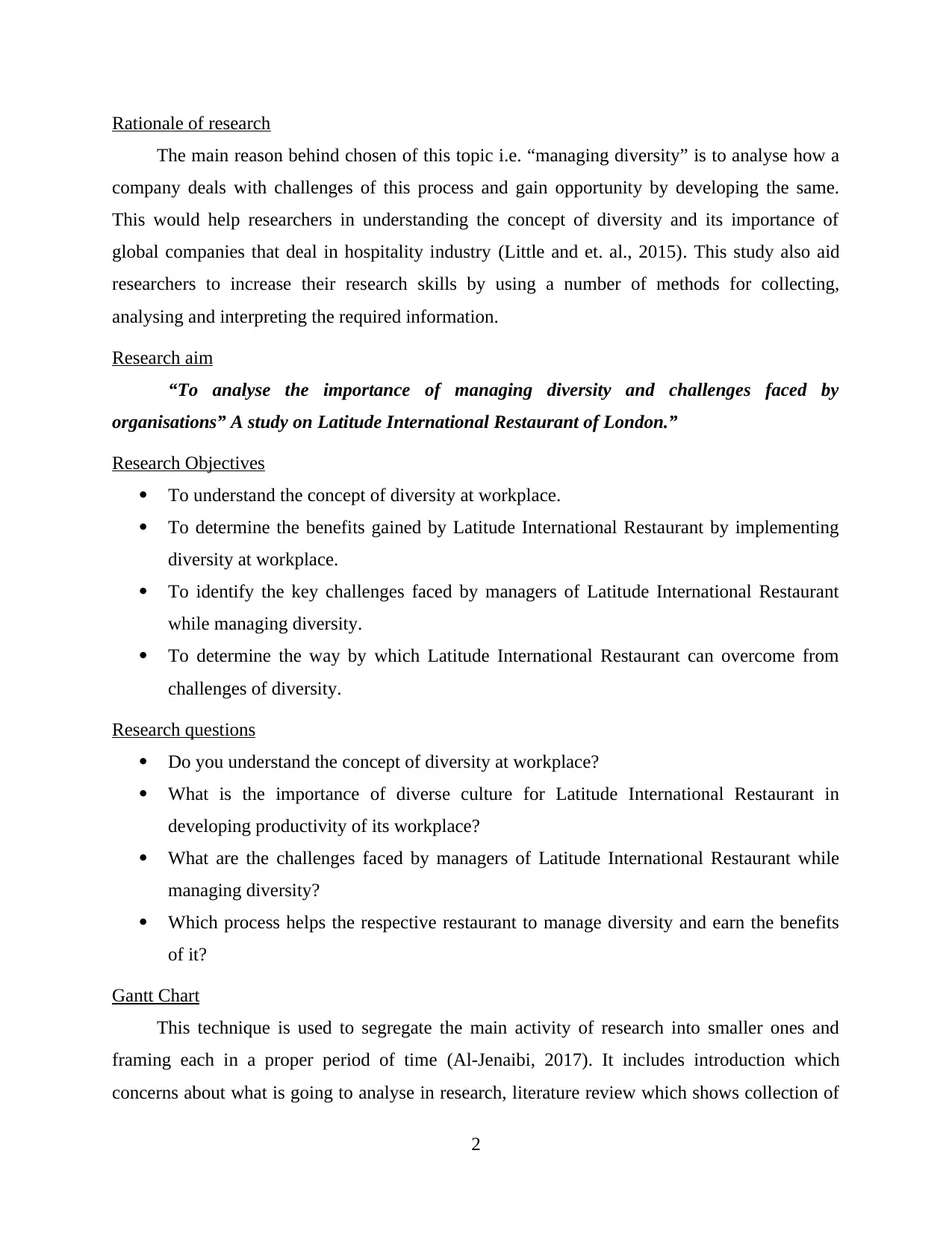
Rationale of research
The main reason behind chosen of this topic i.e. “managing diversity” is to analyse how a
company deals with challenges of this process and gain opportunity by developing the same.
This would help researchers in understanding the concept of diversity and its importance of
global companies that deal in hospitality industry (Little and et. al., 2015). This study also aid
researchers to increase their research skills by using a number of methods for collecting,
analysing and interpreting the required information.
Research aim
“To analyse the importance of managing diversity and challenges faced by
organisations” A study on Latitude International Restaurant of London.”
Research Objectives
To understand the concept of diversity at workplace.
To determine the benefits gained by Latitude International Restaurant by implementing
diversity at workplace.
To identify the key challenges faced by managers of Latitude International Restaurant
while managing diversity.
To determine the way by which Latitude International Restaurant can overcome from
challenges of diversity.
Research questions
Do you understand the concept of diversity at workplace?
What is the importance of diverse culture for Latitude International Restaurant in
developing productivity of its workplace?
What are the challenges faced by managers of Latitude International Restaurant while
managing diversity?
Which process helps the respective restaurant to manage diversity and earn the benefits
of it?
Gantt Chart
This technique is used to segregate the main activity of research into smaller ones and
framing each in a proper period of time (Al-Jenaibi, 2017). It includes introduction which
concerns about what is going to analyse in research, literature review which shows collection of
2
The main reason behind chosen of this topic i.e. “managing diversity” is to analyse how a
company deals with challenges of this process and gain opportunity by developing the same.
This would help researchers in understanding the concept of diversity and its importance of
global companies that deal in hospitality industry (Little and et. al., 2015). This study also aid
researchers to increase their research skills by using a number of methods for collecting,
analysing and interpreting the required information.
Research aim
“To analyse the importance of managing diversity and challenges faced by
organisations” A study on Latitude International Restaurant of London.”
Research Objectives
To understand the concept of diversity at workplace.
To determine the benefits gained by Latitude International Restaurant by implementing
diversity at workplace.
To identify the key challenges faced by managers of Latitude International Restaurant
while managing diversity.
To determine the way by which Latitude International Restaurant can overcome from
challenges of diversity.
Research questions
Do you understand the concept of diversity at workplace?
What is the importance of diverse culture for Latitude International Restaurant in
developing productivity of its workplace?
What are the challenges faced by managers of Latitude International Restaurant while
managing diversity?
Which process helps the respective restaurant to manage diversity and earn the benefits
of it?
Gantt Chart
This technique is used to segregate the main activity of research into smaller ones and
framing each in a proper period of time (Al-Jenaibi, 2017). It includes introduction which
concerns about what is going to analyse in research, literature review which shows collection of
2
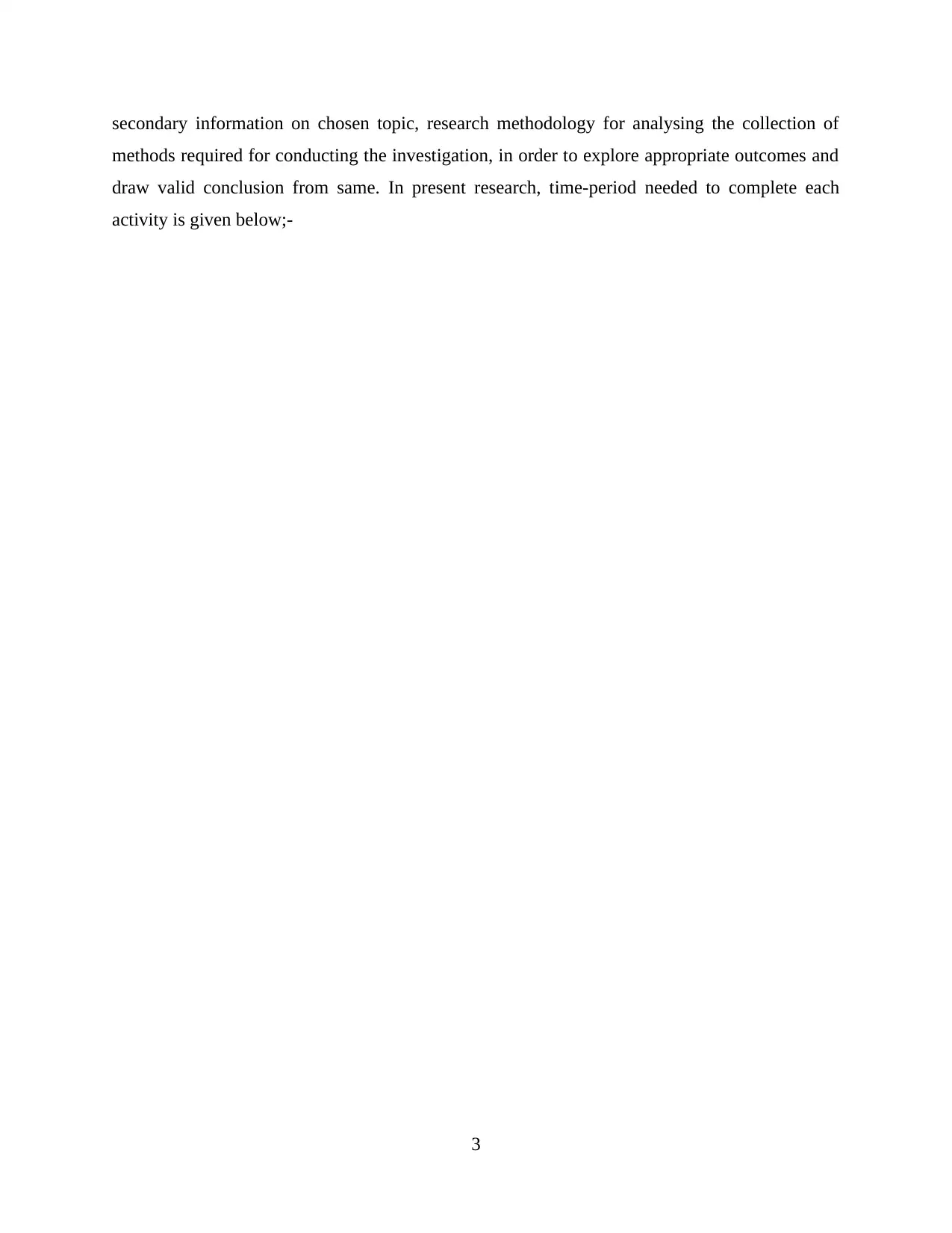
secondary information on chosen topic, research methodology for analysing the collection of
methods required for conducting the investigation, in order to explore appropriate outcomes and
draw valid conclusion from same. In present research, time-period needed to complete each
activity is given below;-
3
methods required for conducting the investigation, in order to explore appropriate outcomes and
draw valid conclusion from same. In present research, time-period needed to complete each
activity is given below;-
3
⊘ This is a preview!⊘
Do you want full access?
Subscribe today to unlock all pages.

Trusted by 1+ million students worldwide
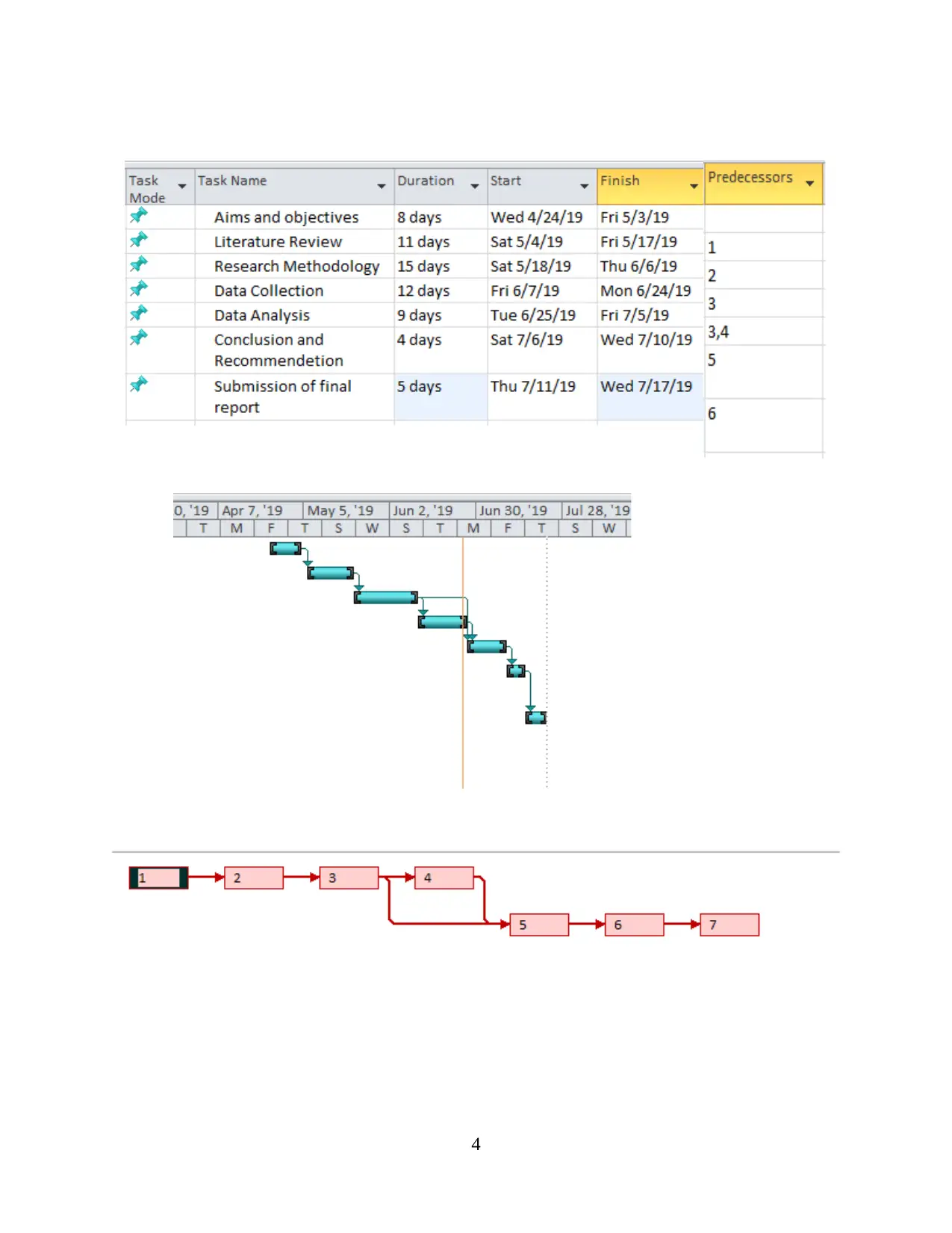
4
Paraphrase This Document
Need a fresh take? Get an instant paraphrase of this document with our AI Paraphraser
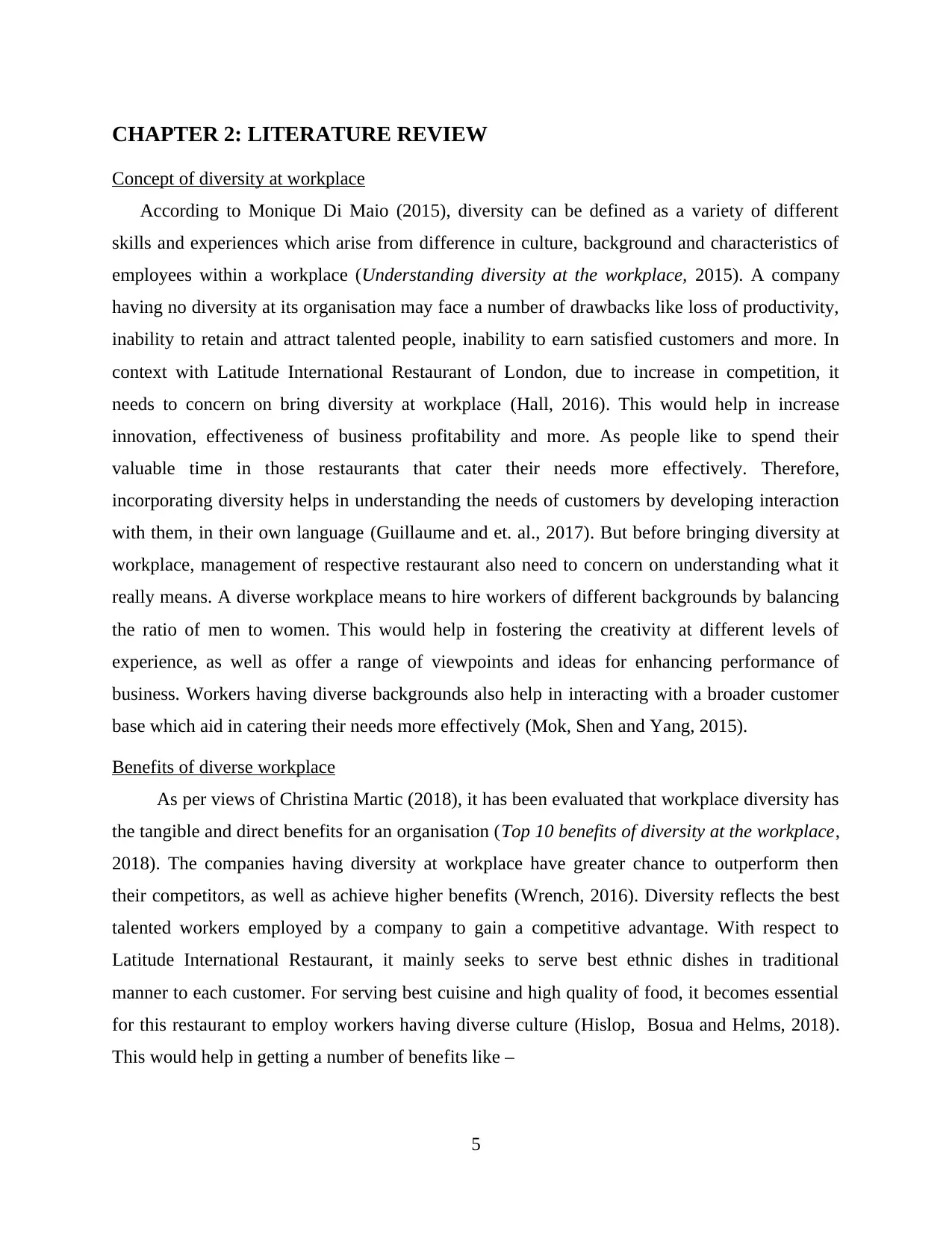
CHAPTER 2: LITERATURE REVIEW
Concept of diversity at workplace
According to Monique Di Maio (2015), diversity can be defined as a variety of different
skills and experiences which arise from difference in culture, background and characteristics of
employees within a workplace (Understanding diversity at the workplace, 2015). A company
having no diversity at its organisation may face a number of drawbacks like loss of productivity,
inability to retain and attract talented people, inability to earn satisfied customers and more. In
context with Latitude International Restaurant of London, due to increase in competition, it
needs to concern on bring diversity at workplace (Hall, 2016). This would help in increase
innovation, effectiveness of business profitability and more. As people like to spend their
valuable time in those restaurants that cater their needs more effectively. Therefore,
incorporating diversity helps in understanding the needs of customers by developing interaction
with them, in their own language (Guillaume and et. al., 2017). But before bringing diversity at
workplace, management of respective restaurant also need to concern on understanding what it
really means. A diverse workplace means to hire workers of different backgrounds by balancing
the ratio of men to women. This would help in fostering the creativity at different levels of
experience, as well as offer a range of viewpoints and ideas for enhancing performance of
business. Workers having diverse backgrounds also help in interacting with a broader customer
base which aid in catering their needs more effectively (Mok, Shen and Yang, 2015).
Benefits of diverse workplace
As per views of Christina Martic (2018), it has been evaluated that workplace diversity has
the tangible and direct benefits for an organisation (Top 10 benefits of diversity at the workplace,
2018). The companies having diversity at workplace have greater chance to outperform then
their competitors, as well as achieve higher benefits (Wrench, 2016). Diversity reflects the best
talented workers employed by a company to gain a competitive advantage. With respect to
Latitude International Restaurant, it mainly seeks to serve best ethnic dishes in traditional
manner to each customer. For serving best cuisine and high quality of food, it becomes essential
for this restaurant to employ workers having diverse culture (Hislop, Bosua and Helms, 2018).
This would help in getting a number of benefits like –
5
Concept of diversity at workplace
According to Monique Di Maio (2015), diversity can be defined as a variety of different
skills and experiences which arise from difference in culture, background and characteristics of
employees within a workplace (Understanding diversity at the workplace, 2015). A company
having no diversity at its organisation may face a number of drawbacks like loss of productivity,
inability to retain and attract talented people, inability to earn satisfied customers and more. In
context with Latitude International Restaurant of London, due to increase in competition, it
needs to concern on bring diversity at workplace (Hall, 2016). This would help in increase
innovation, effectiveness of business profitability and more. As people like to spend their
valuable time in those restaurants that cater their needs more effectively. Therefore,
incorporating diversity helps in understanding the needs of customers by developing interaction
with them, in their own language (Guillaume and et. al., 2017). But before bringing diversity at
workplace, management of respective restaurant also need to concern on understanding what it
really means. A diverse workplace means to hire workers of different backgrounds by balancing
the ratio of men to women. This would help in fostering the creativity at different levels of
experience, as well as offer a range of viewpoints and ideas for enhancing performance of
business. Workers having diverse backgrounds also help in interacting with a broader customer
base which aid in catering their needs more effectively (Mok, Shen and Yang, 2015).
Benefits of diverse workplace
As per views of Christina Martic (2018), it has been evaluated that workplace diversity has
the tangible and direct benefits for an organisation (Top 10 benefits of diversity at the workplace,
2018). The companies having diversity at workplace have greater chance to outperform then
their competitors, as well as achieve higher benefits (Wrench, 2016). Diversity reflects the best
talented workers employed by a company to gain a competitive advantage. With respect to
Latitude International Restaurant, it mainly seeks to serve best ethnic dishes in traditional
manner to each customer. For serving best cuisine and high quality of food, it becomes essential
for this restaurant to employ workers having diverse culture (Hislop, Bosua and Helms, 2018).
This would help in getting a number of benefits like –
5
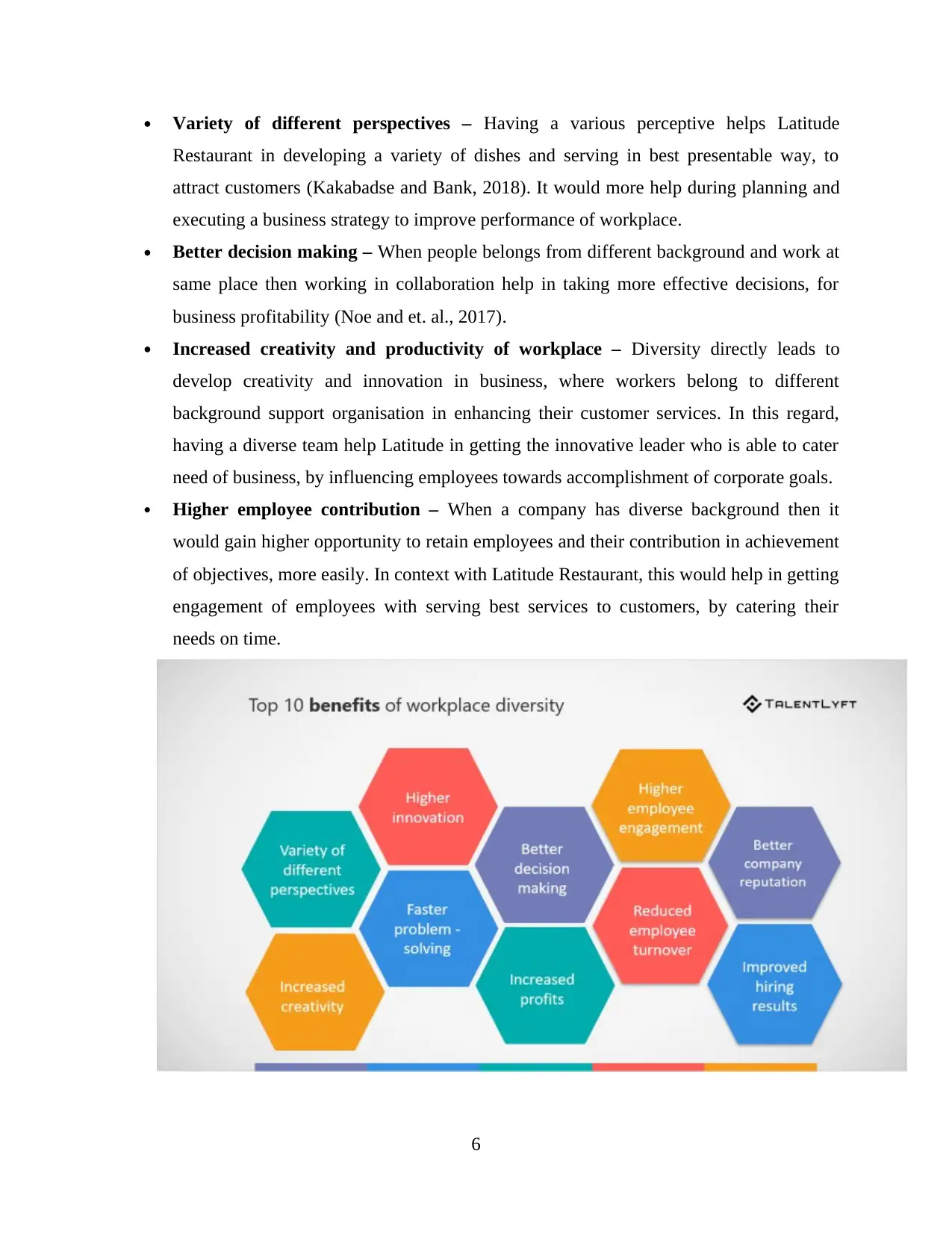
Variety of different perspectives – Having a various perceptive helps Latitude
Restaurant in developing a variety of dishes and serving in best presentable way, to
attract customers (Kakabadse and Bank, 2018). It would more help during planning and
executing a business strategy to improve performance of workplace.
Better decision making – When people belongs from different background and work at
same place then working in collaboration help in taking more effective decisions, for
business profitability (Noe and et. al., 2017).
Increased creativity and productivity of workplace – Diversity directly leads to
develop creativity and innovation in business, where workers belong to different
background support organisation in enhancing their customer services. In this regard,
having a diverse team help Latitude in getting the innovative leader who is able to cater
need of business, by influencing employees towards accomplishment of corporate goals.
Higher employee contribution – When a company has diverse background then it
would gain higher opportunity to retain employees and their contribution in achievement
of objectives, more easily. In context with Latitude Restaurant, this would help in getting
engagement of employees with serving best services to customers, by catering their
needs on time.
6
Restaurant in developing a variety of dishes and serving in best presentable way, to
attract customers (Kakabadse and Bank, 2018). It would more help during planning and
executing a business strategy to improve performance of workplace.
Better decision making – When people belongs from different background and work at
same place then working in collaboration help in taking more effective decisions, for
business profitability (Noe and et. al., 2017).
Increased creativity and productivity of workplace – Diversity directly leads to
develop creativity and innovation in business, where workers belong to different
background support organisation in enhancing their customer services. In this regard,
having a diverse team help Latitude in getting the innovative leader who is able to cater
need of business, by influencing employees towards accomplishment of corporate goals.
Higher employee contribution – When a company has diverse background then it
would gain higher opportunity to retain employees and their contribution in achievement
of objectives, more easily. In context with Latitude Restaurant, this would help in getting
engagement of employees with serving best services to customers, by catering their
needs on time.
6
⊘ This is a preview!⊘
Do you want full access?
Subscribe today to unlock all pages.

Trusted by 1+ million students worldwide

Challenges faced by organisations in managing diversity
According to the views of Kakabadse and Bank (2018), it has been analysed that apart
from various benefits of diversity, a company faces a number of challenges also (Managing
workplace diversity: Issues and Challenges. 2012). It includes ethnic and cultural difference, gap
skills due to difference in language and communication, collaboration among workers and more,
all these challenges lead to create the major conflicts among workers that impact directly on their
performance and behaviour. Hereby, ethnic and cultural different may create discrimination at
workplace, which leads to adversely affect business reputation. Similarly, language and
communication difference among workers, create challenge for management of Latitude
Restaurant in developing collaboration between them. When new workers are hired at workplace
who are extremely talented then, it leads to increase generation and skill gap between workers as
well. This may demotivate other workers who are less skilled and generate conflicts among
them. Therefore, under such conditions, it becomes essential for respective restaurant to develop
effective strategies for managing diversity at workplace and gain higher benefits of the same.
Ways to deal with challenges of managing diversity
According to Harold Patrick and Vencent (2019), diversity management can be defined as a
process of creating and maintaining a positive work environment at workplace, where the
similarities and differences of each individual is valued (How to manage diversity at workplace,
2019). The concept of diversity mainly emphasize on acceptance and respect culture of each
worker so that higher contribution of them can be gained, to achieve business objectives. But as
it create various challenges for organisations, therefore, the ways through which Latitude
Restaurant can deal with same are given below:-
Spot problems and overcome from them: In order to deal with diversity, it is essential
for management of Latitude restaurant to identify problems that arise barriers in
incorporating diversity at workplace (Jansen and et. al., 2016). This would help in
developing effective strategies to deal with challenges and managing diversity more
effectively.
Organizing training for reducing communication gap: As main challenging role in
front of respective restaurant to implement diversity is communication and language gap.
Therefore, by organizing training where workers gain opportunity to improve weaknesses
and learn new languages, will help in developing effective collaboration among them.
7
According to the views of Kakabadse and Bank (2018), it has been analysed that apart
from various benefits of diversity, a company faces a number of challenges also (Managing
workplace diversity: Issues and Challenges. 2012). It includes ethnic and cultural difference, gap
skills due to difference in language and communication, collaboration among workers and more,
all these challenges lead to create the major conflicts among workers that impact directly on their
performance and behaviour. Hereby, ethnic and cultural different may create discrimination at
workplace, which leads to adversely affect business reputation. Similarly, language and
communication difference among workers, create challenge for management of Latitude
Restaurant in developing collaboration between them. When new workers are hired at workplace
who are extremely talented then, it leads to increase generation and skill gap between workers as
well. This may demotivate other workers who are less skilled and generate conflicts among
them. Therefore, under such conditions, it becomes essential for respective restaurant to develop
effective strategies for managing diversity at workplace and gain higher benefits of the same.
Ways to deal with challenges of managing diversity
According to Harold Patrick and Vencent (2019), diversity management can be defined as a
process of creating and maintaining a positive work environment at workplace, where the
similarities and differences of each individual is valued (How to manage diversity at workplace,
2019). The concept of diversity mainly emphasize on acceptance and respect culture of each
worker so that higher contribution of them can be gained, to achieve business objectives. But as
it create various challenges for organisations, therefore, the ways through which Latitude
Restaurant can deal with same are given below:-
Spot problems and overcome from them: In order to deal with diversity, it is essential
for management of Latitude restaurant to identify problems that arise barriers in
incorporating diversity at workplace (Jansen and et. al., 2016). This would help in
developing effective strategies to deal with challenges and managing diversity more
effectively.
Organizing training for reducing communication gap: As main challenging role in
front of respective restaurant to implement diversity is communication and language gap.
Therefore, by organizing training where workers gain opportunity to improve weaknesses
and learn new languages, will help in developing effective collaboration among them.
7
Paraphrase This Document
Need a fresh take? Get an instant paraphrase of this document with our AI Paraphraser
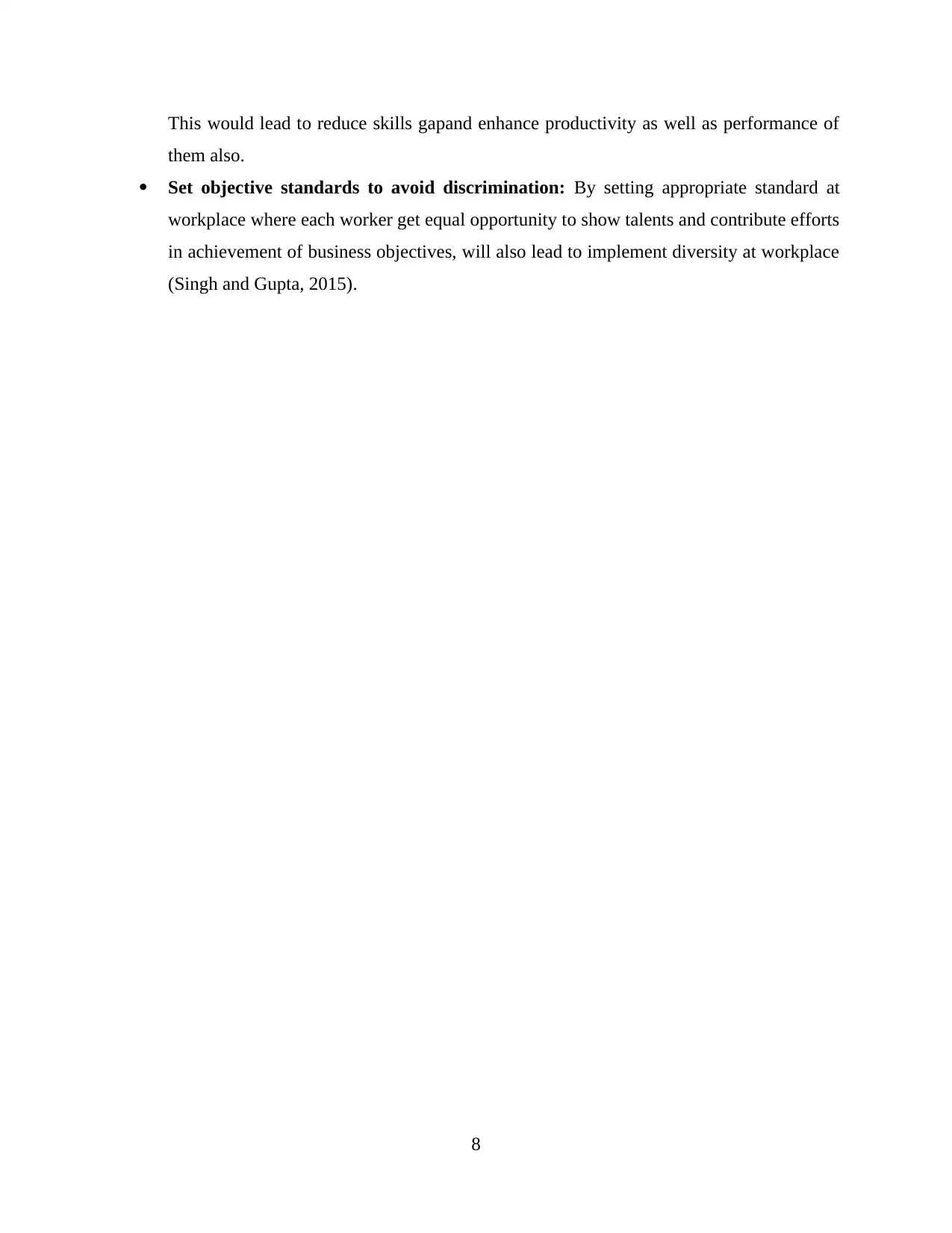
This would lead to reduce skills gapand enhance productivity as well as performance of
them also.
Set objective standards to avoid discrimination: By setting appropriate standard at
workplace where each worker get equal opportunity to show talents and contribute efforts
in achievement of business objectives, will also lead to implement diversity at workplace
(Singh and Gupta, 2015).
8
them also.
Set objective standards to avoid discrimination: By setting appropriate standard at
workplace where each worker get equal opportunity to show talents and contribute efforts
in achievement of business objectives, will also lead to implement diversity at workplace
(Singh and Gupta, 2015).
8
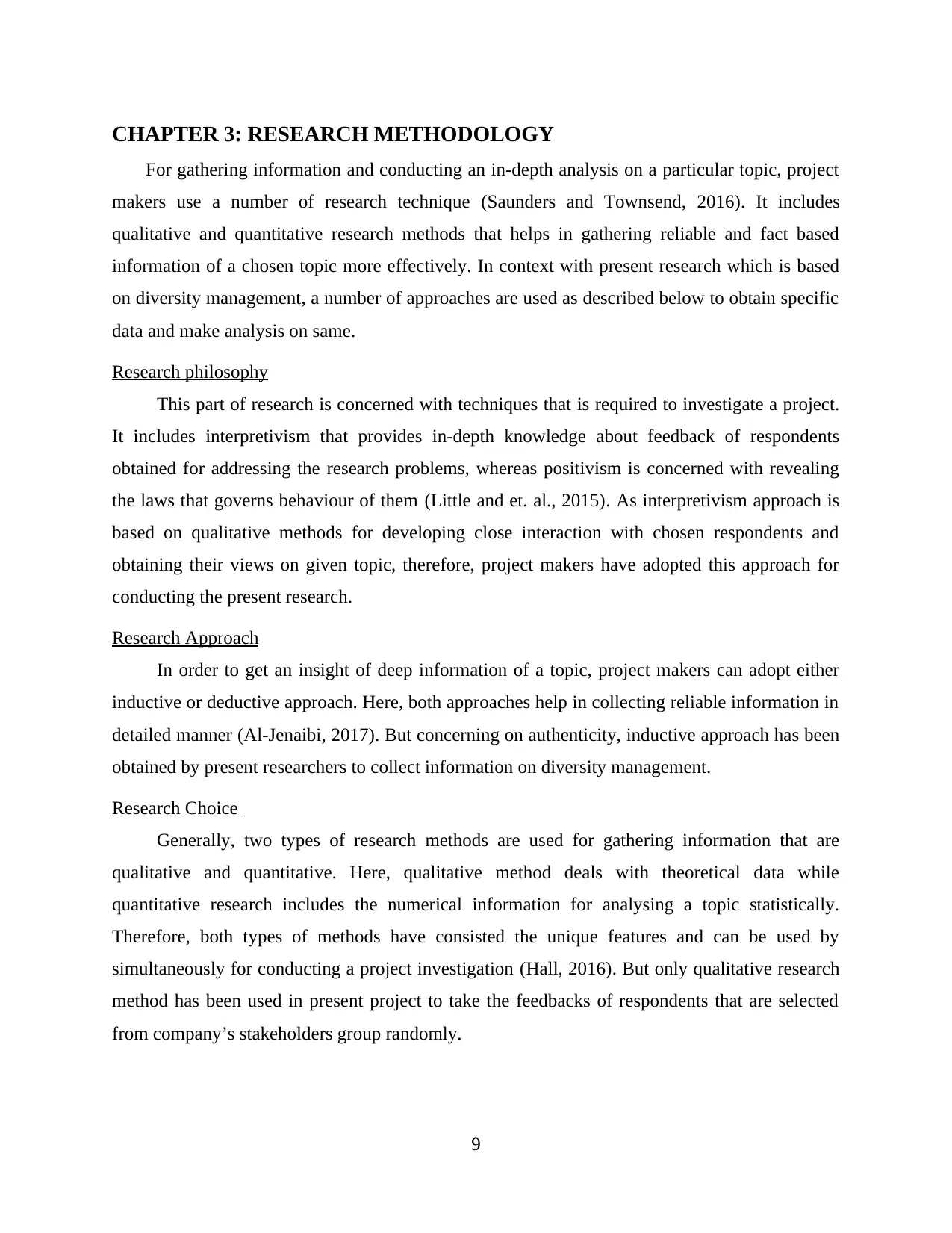
CHAPTER 3: RESEARCH METHODOLOGY
For gathering information and conducting an in-depth analysis on a particular topic, project
makers use a number of research technique (Saunders and Townsend, 2016). It includes
qualitative and quantitative research methods that helps in gathering reliable and fact based
information of a chosen topic more effectively. In context with present research which is based
on diversity management, a number of approaches are used as described below to obtain specific
data and make analysis on same.
Research philosophy
This part of research is concerned with techniques that is required to investigate a project.
It includes interpretivism that provides in-depth knowledge about feedback of respondents
obtained for addressing the research problems, whereas positivism is concerned with revealing
the laws that governs behaviour of them (Little and et. al., 2015). As interpretivism approach is
based on qualitative methods for developing close interaction with chosen respondents and
obtaining their views on given topic, therefore, project makers have adopted this approach for
conducting the present research.
Research Approach
In order to get an insight of deep information of a topic, project makers can adopt either
inductive or deductive approach. Here, both approaches help in collecting reliable information in
detailed manner (Al-Jenaibi, 2017). But concerning on authenticity, inductive approach has been
obtained by present researchers to collect information on diversity management.
Research Choice
Generally, two types of research methods are used for gathering information that are
qualitative and quantitative. Here, qualitative method deals with theoretical data while
quantitative research includes the numerical information for analysing a topic statistically.
Therefore, both types of methods have consisted the unique features and can be used by
simultaneously for conducting a project investigation (Hall, 2016). But only qualitative research
method has been used in present project to take the feedbacks of respondents that are selected
from company’s stakeholders group randomly.
9
For gathering information and conducting an in-depth analysis on a particular topic, project
makers use a number of research technique (Saunders and Townsend, 2016). It includes
qualitative and quantitative research methods that helps in gathering reliable and fact based
information of a chosen topic more effectively. In context with present research which is based
on diversity management, a number of approaches are used as described below to obtain specific
data and make analysis on same.
Research philosophy
This part of research is concerned with techniques that is required to investigate a project.
It includes interpretivism that provides in-depth knowledge about feedback of respondents
obtained for addressing the research problems, whereas positivism is concerned with revealing
the laws that governs behaviour of them (Little and et. al., 2015). As interpretivism approach is
based on qualitative methods for developing close interaction with chosen respondents and
obtaining their views on given topic, therefore, project makers have adopted this approach for
conducting the present research.
Research Approach
In order to get an insight of deep information of a topic, project makers can adopt either
inductive or deductive approach. Here, both approaches help in collecting reliable information in
detailed manner (Al-Jenaibi, 2017). But concerning on authenticity, inductive approach has been
obtained by present researchers to collect information on diversity management.
Research Choice
Generally, two types of research methods are used for gathering information that are
qualitative and quantitative. Here, qualitative method deals with theoretical data while
quantitative research includes the numerical information for analysing a topic statistically.
Therefore, both types of methods have consisted the unique features and can be used by
simultaneously for conducting a project investigation (Hall, 2016). But only qualitative research
method has been used in present project to take the feedbacks of respondents that are selected
from company’s stakeholders group randomly.
9
⊘ This is a preview!⊘
Do you want full access?
Subscribe today to unlock all pages.

Trusted by 1+ million students worldwide
1 out of 30
Related Documents
Your All-in-One AI-Powered Toolkit for Academic Success.
+13062052269
info@desklib.com
Available 24*7 on WhatsApp / Email
![[object Object]](/_next/static/media/star-bottom.7253800d.svg)
Unlock your academic potential
Copyright © 2020–2025 A2Z Services. All Rights Reserved. Developed and managed by ZUCOL.





